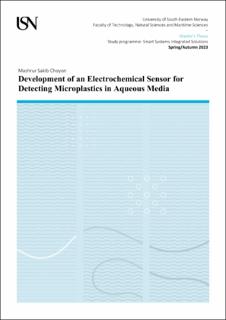| dc.description.abstract | Microplastic pollution has become a significant environmental concern due to its adverse effects on ecosystems and human health. In this master's thesis, the development of an electrochemical sensor for the detection of microplastics in aqueous media is presented. The sensor was developed utilizing the “impact concept” which basically states that the microplastic particles generate a signal at the time of making impacts with the working electrode of the sensor. From the attained signals of these impacts, microplastic particles present in the aqueous sample were detected utilizing the spike counts generated from the impacts and quantified using FFT analysis. The result shows that for microplastics concentrations as volume fractions (v/v) 0.005%, 0.02%, 0.03%, and 0.04%, prominent peaks are observed around 5 Hz, 20 Hz, 21 Hz, and 24 Hz respectively, whereas the control solution of 0% displayed no such peaks. Electrochemical impedance spectroscopy (EIS) was studied as an alternative detection modality for the detection and quantification of microparticles where a calibration coefficient was determined in terms of constant phase element (CPE) for the aqueous solution with the absence of microplastics and different concentrations of microplastics in the solution.
This thesis report begins with a brief introduction to the project. A comprehensive review of literature and background studies from which the motivation for this research work emerged is also presented. The obtained results demonstrate the sensor's capability to detect microplastics utilizing a 100 nA range current and exhibit a linear response over a wide concentration range. The developed electrochemical sensor can quickly and directly detect microplastics in aqueous solutions. It is a potential instrument for environmental research and monitoring due to its relatively simple design and operation. A possible improvement of the sensor can be made on the working electrode’s diameter, as it should be reduced to below 10 µm to increase its capability to detect microplastic particles individually. The sensor is intended to be part of a system where microplastics are pre-concentrated at the sensor through an acoustic actuator focusing on an integrated microfluidic device. | |
